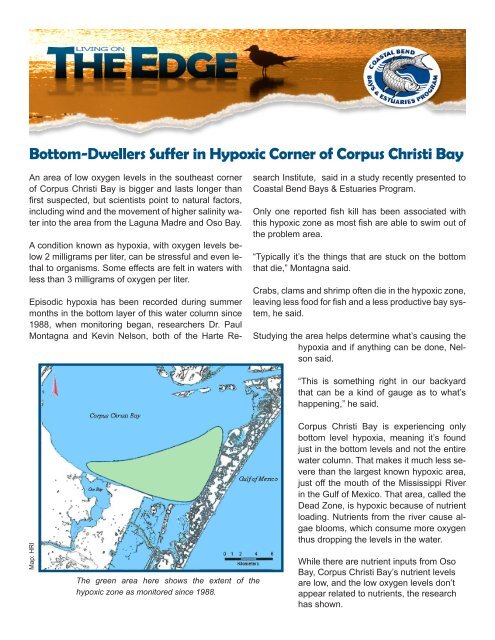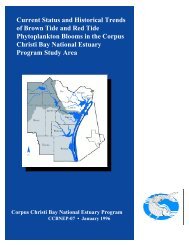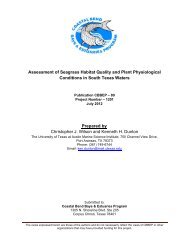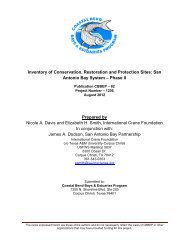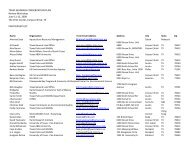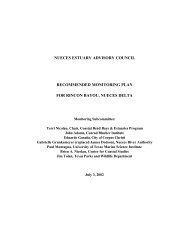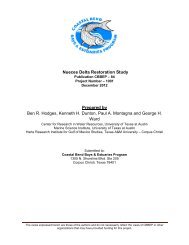Bottom-Dwellers Suffer in Hypoxic Corner of Corpus Christi Bay
Bottom-Dwellers Suffer in Hypoxic Corner of Corpus Christi Bay
Bottom-Dwellers Suffer in Hypoxic Corner of Corpus Christi Bay
You also want an ePaper? Increase the reach of your titles
YUMPU automatically turns print PDFs into web optimized ePapers that Google loves.
<strong>Bottom</strong>-<strong>Dwellers</strong> <strong>Suffer</strong> <strong>in</strong> <strong>Hypoxic</strong> <strong>Corner</strong> <strong>of</strong> <strong>Corpus</strong> <strong>Christi</strong> <strong>Bay</strong><br />
An area <strong>of</strong> low oxygen levels <strong>in</strong> the southeast corner<br />
<strong>of</strong> <strong>Corpus</strong> <strong>Christi</strong> <strong>Bay</strong> is bigger and lasts longer than<br />
first suspected, but scientists po<strong>in</strong>t to natural factors,<br />
<strong>in</strong>clud<strong>in</strong>g w<strong>in</strong>d and the movement <strong>of</strong> higher sal<strong>in</strong>ity water<br />
<strong>in</strong>to the area from the Laguna Madre and Oso <strong>Bay</strong>.<br />
A condition known as hypoxia, with oxygen levels below<br />
2 milligrams per liter, can be stressful and even lethal<br />
to organisms. Some effects are felt <strong>in</strong> waters with<br />
less than 3 milligrams <strong>of</strong> oxygen per liter.<br />
Episodic hypoxia has been recorded dur<strong>in</strong>g summer<br />
months <strong>in</strong> the bottom layer <strong>of</strong> this water column s<strong>in</strong>ce<br />
1988, when monitor<strong>in</strong>g began, researchers Dr. Paul<br />
Montagna and Kev<strong>in</strong> Nelson, both <strong>of</strong> the Harte Research<br />
Institute, said <strong>in</strong> a study recently presented to<br />
Coastal Bend <strong>Bay</strong>s & Estuaries Program.<br />
Only one reported fish kill has been associated with<br />
this hypoxic zone as most fish are able to swim out <strong>of</strong><br />
the problem area.<br />
“Typically it’s the th<strong>in</strong>gs that are stuck on the bottom<br />
that die,” Montagna said.<br />
Crabs, clams and shrimp <strong>of</strong>ten die <strong>in</strong> the hypoxic zone,<br />
leav<strong>in</strong>g less food for fish and a less productive bay system,<br />
he said.<br />
Study<strong>in</strong>g the area helps determ<strong>in</strong>e what’s caus<strong>in</strong>g the<br />
hypoxia and if anyth<strong>in</strong>g can be done, Nelson<br />
said.<br />
“This is someth<strong>in</strong>g right <strong>in</strong> our backyard<br />
that can be a k<strong>in</strong>d <strong>of</strong> gauge as to what’s<br />
happen<strong>in</strong>g,” he said.<br />
<strong>Corpus</strong> <strong>Christi</strong> <strong>Bay</strong> is experienc<strong>in</strong>g only<br />
bottom level hypoxia, mean<strong>in</strong>g it’s found<br />
just <strong>in</strong> the bottom levels and not the entire<br />
water column. That makes it much less severe<br />
than the largest known hypoxic area,<br />
just <strong>of</strong>f the mouth <strong>of</strong> the Mississippi River<br />
<strong>in</strong> the Gulf <strong>of</strong> Mexico. That area, called the<br />
Dead Zone, is hypoxic because <strong>of</strong> nutrient<br />
load<strong>in</strong>g. Nutrients from the river cause algae<br />
blooms, which consume more oxygen<br />
thus dropp<strong>in</strong>g the levels <strong>in</strong> the water.<br />
While there are nutrient <strong>in</strong>puts from Oso<br />
<strong>Bay</strong>, <strong>Corpus</strong> <strong>Christi</strong> <strong>Bay</strong>’s nutrient levels<br />
are low, and the low oxygen levels don’t<br />
appear related to nutrients, the research<br />
has shown.
The strong southwest w<strong>in</strong>ds <strong>of</strong> summer blow<br />
higher sal<strong>in</strong>ity water from the Laguna Madre<br />
and Oso <strong>Bay</strong> <strong>in</strong>to <strong>Corpus</strong> <strong>Christi</strong> <strong>Bay</strong>, and<br />
this contributes to stratification <strong>of</strong> the water<br />
column. This layer<strong>in</strong>g <strong>of</strong> the water column<br />
has two effects: bottom-water is isolated and<br />
oxygen is consumed by benthic organisms,<br />
and the layer<strong>in</strong>g prevents mix<strong>in</strong>g, which<br />
would br<strong>in</strong>g oxygen-rich water from the<br />
surface to the lower levels. The layer<strong>in</strong>g occurs<br />
<strong>in</strong> low spots <strong>in</strong> the bay between bottom<br />
ridges.<br />
Another factor, the water here, with higher<br />
temperature and higher sal<strong>in</strong>ity, holds less<br />
oxygen, further reduc<strong>in</strong>g its levels.<br />
The next area <strong>of</strong> study will look at whether<br />
contours along the bay bottom are <strong>in</strong>terfer<strong>in</strong>g<br />
with water flow and result<strong>in</strong>g <strong>in</strong> unmixed and<br />
hypoxic water layers.<br />
“There may be an eng<strong>in</strong>eer<strong>in</strong>g solution to this problem,” Montagna said. Adjust<strong>in</strong>g the bottom elevation could<br />
improve water circulation, result<strong>in</strong>g <strong>in</strong> <strong>in</strong>creased oxygen levels <strong>in</strong> these bottom layers.<br />
While the factors creat<strong>in</strong>g hypoxia are naturally occurr<strong>in</strong>g, research <strong>in</strong>dicates it appears to be gett<strong>in</strong>g worse.<br />
Nelson said the research provides a start<strong>in</strong>g po<strong>in</strong>t to monitor <strong>in</strong>com<strong>in</strong>g nutrients to assure they don’t <strong>in</strong>crease<br />
and become a factor <strong>in</strong> the future.<br />
“It’s not nutrient-driven now,” he said. “We want to make sure it stays that way.”<br />
Montagna compared the hypoxic area to the flu. It’s recurr<strong>in</strong>g problem that gets better over time. “But if we don’t<br />
take care <strong>of</strong> it and it starts happen<strong>in</strong>g over and over aga<strong>in</strong>, it can become a serious problem,” he said. “We have<br />
to be very diligent about other stressors <strong>in</strong> the environment. We already have fragile environments.”<br />
Read the full report on hypoxia at www.cbbep.org.<br />
The Coastal Bend <strong>Bay</strong>s & Estuaries Program is a non-pr<strong>of</strong>it organization<br />
dedicated to protect<strong>in</strong>g and restor<strong>in</strong>g bays and estuaries <strong>in</strong> the 12-county<br />
region <strong>of</strong> the Texas Coastal Bend. CBBEP is partially funded by the Texas<br />
Commission on Environmental Quality and the U.S. Environmental Protection<br />
Agency.<br />
For more <strong>in</strong>formation about the Coastal Bend <strong>Bay</strong>s & Estuaries Program,<br />
contact Beth Wilson at (361) 885-6246 or bwilson@cbbep.org.<br />
This report published <strong>in</strong> July 2009.


